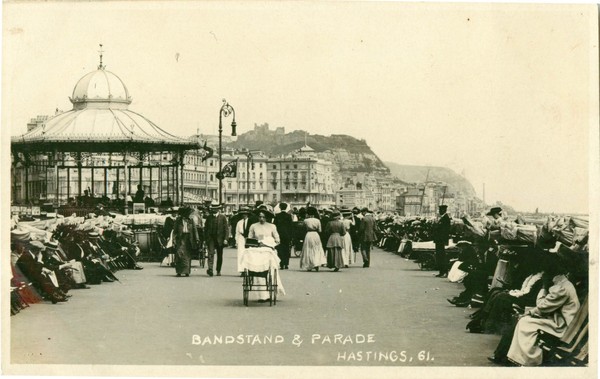William John Willmett

Bandstand & Parade, Hastings
Photographer and shopkeeper, Hastings. Willmett is first recorded in Hastings Directories in 1907, after he had become proprietor of a general store at 8a Gordon Road on West Hill (near Plynlimmon Road). He is believed to have arrived in the town and opened the shop in 1906. During 1908 he acquired a new shop at 14 Pelham Crescent on the seafront, where he traded as a fancy stationer. Pike's 1909 Directory lists him as the proprietor of both the Gordon Road and Pelham Crescent shops, but when the 1910 edition came to be compiled, he had left Gordon Road, and a Miss Bradley had taken over his old shop and was running it as a grocery store.
Although Willmett is often described in Hastings and Sussex Directories as a fancy stationer even as late as 1922, his main interest from about 1909 onwards seems to have been photography and postcard publishing, which must have been quite profitable. Pike's 1913 Directory records that he further supplemented his income by managing 14 Pelham Crescent as a boarding house.
On his Hastings postcards Willmett often described himself as "Pier photographer", and in summer he probably had a booth or table on the pier where he sold postcards (and cajoled people into having their picture taken) in addition to his shop in the Crescent. He remained active as a postcard publisher until the First World War or later, and continued to work as a photographer at Pelham Crescent until after the Second World War. A Kodak dealer, he sold films to holidaymakers and also carried out developing and enlarging. In 1921 and 1922 he worked in partnership with a Mr Tadd, but in 1923 he resumed sole control of the business.
Nearly all the cards that Willmett issued are real photographics, but he published a few handsome, glossy-surfaced black and white collotypes of Hastings with white borders emphasised by rule lines. The collotype cards are labelled "Wilimett (sic) Pelham Crescent. Hastings (Copyright)" on the back. No postmarks have been reported.
Willmett's real photographic cards are good quality sepia or black and white views. Early cards generally have narrow white borders, but later cards often lack borders. Unusually, several of the photographs include clouds; these may have been added from separate negatives. The captions, when present, are generally handwritten (more rarely printed), usually in small plain capitals, but sometimes with decorative descenders and other embellishments. The lettering is sometimes backwards sloping. Judging from the variations in handwriting, several persons must have prepared the captions. On a few cards the captions are badly placed, for example in the middle of the picture. The highest serial number noted is 702. Although many cards have Willmett's name and address on the back, others are anonymous.
One of Willmett's earliest real photographic cards shows a Drumhead Service at Hastings in the summer of 1907. Other subjects include Warrior Square at St Leonards (1919 postmark), the East and West Hills at Hastings (1914 postmark noted), Hastings Pier (1917 postmark), Hastings Castle (1912 postmark), the interior of St Clements Caves (many sepia-toned cards, often issued anonymously), Eversfield Place, rough seas at Carolina Place, shingle covering the nearby promenade (1914 postmark), Bexhill, Ecclesbourne Glen, Bodiam Castle and Rye (1910 postmark noted). Many visitors to Hastings purchased his real photographic cards of towering seas breaking against Hastings promenade, which were often issued anonymously. He also sold cards of groups of holidaymakers at the Pier and on the sea front.
Pelham Crescent features on many Hastings postcards. Willmett's shop at the western end of the Crescent is clearly visible on several of these cards, including at least one issued by Willmett himself.
Although Willmett worked mostly in the open air, he sometimes undertook studio portraiture. Clients could opt to have their portraits made into postcards, which Willmett blind stamped with his name and address.
According to Philip Richards, William John Willmett was the grandson of John Willmett, coachman at Petworth House, who was born in 1794. William John was born in Chelsea in 1869, the youngest of six children of Helen Georgiana Pearce and her husband, Joseph Hill Willmett, a confectioner, who had been born and raised in Devon. For many years William John Willmett worked as a publican. In February 1897 at Hounslow parish church he married Mrs Jenny Manders (previously Jenny Bennett), who was five years his senior and a widow. There were no children from the marriage when Jenny died in 1906. It was following her death that William John decided to leave London and set up in business in Hastings. After many years as a widower, he finally remarried early in 1920, at Brentford. His new wife was Fanny Louisa Meek, who had been born in 1887 at Belper in Derbyshire and was the daughter of a photographer. She gave birth to a son, John Roy Willmett, at Hastings on August 7, 1920. There were no other children from this second marriage. After leaving school John Roy helped his father run the Pelham Crescent photography business. Hastings Directories for the late 1930s and early 1940s refer to a Mrs D. J. Willmett at 14a Pelham Crescent, who was a confectioner and supplier of "homemade cakes". Her connection to the family remains unclear.
William John Willmett and his son continued the Pelham Crescent photography business until 1950 or later. William John died at St Helens Hospital in Hastings on 14 February 1956 at the age of 86. Probate on the estate was valued at £3528. John Roy Willmett died in 1985 at Tunbridge Wells, aged 65.
Acknowledgement: Grateful thanks are due to Philip Richards for assisting with details of the Willmett family history and for pointing out errors in an earlier version of this account.
To directory of publishersTo gallery
Design: Lucid Design
© www.sussexpostcards.info
